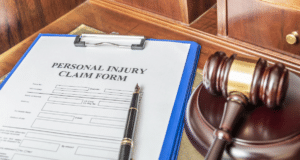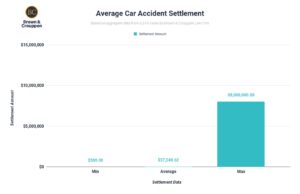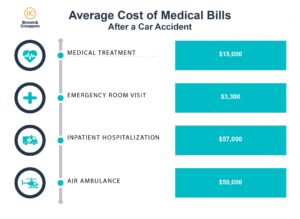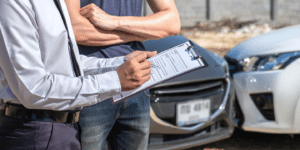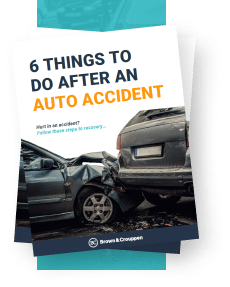1. Move to a Safe Location
2. Call 911 and Report the Accident
Contact 911 to report the crash. Inform the dispatcher whether:
- The accident is minor or severe.
- There are injuries that may require medical attention.
- Vehicles are blocking the roadway and need to be removed.
Even for minor accidents, having a police report is crucial for insurance claims, and monitor your symptoms and visit a doctor if you experience pain or discomfort in the days following the crash.
For severe accidents, go to the emergency room immediately to get evaluated, even if you don’t feel injured. Document your symptoms in a journal until you receive medical attention.
3. Exit Your Vehicle Safely
If it is safe to do so, exit your vehicle to inspect the damage. For severe accidents, remain in your vehicle until law enforcement and emergency personnel secure the scene unless it is unsafe to stay inside.
4. Document the Scene
Take photographs of the following:
- Damage to all vehicles involved.
- License plates of all vehicles.
- Roadway hazards, traffic conditions, or anything unusual at the crash site.
- For severe accidents, take photos from inside your vehicle showing the view in front and behind.
Also, look for traffic or surveillance cameras and make a note of their locations.
5. Exchange Information
Exchange names, contact details, and insurance information with the other driver. If you are uncomfortable or the other driver leaves before police arrive, law enforcement will collect this information for you.
6. Observe Your Surroundings and Gather Evidence
Take note of:
- Witnesses who stop to help and their contact information.
- Traffic cameras, businesses, or residences nearby that may have video footage.
- Anything out of the ordinary, such as road conditions or weather factors.
7. Secure Personal Belongings
Before your vehicle is towed, remove any valuables and personal items if it is safe to do so. For severe crashes, photograph all valuable items and personal belongings inside the vehicle, including child safety seats, which will need to be replaced.
8. Notify Your Employer
Inform your employer if you miss work due to injuries or medical appointments. Request documentation of missed time in your personnel file.
By following these steps, you can protect your safety, document the accident, and safeguard your right to compensation for any damages or injuries.
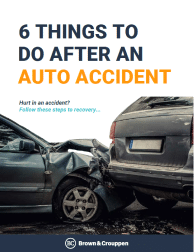

Use our legal checklist to learn what to do after an accident and understand key legal considerations for recovering financial compensation.
How To File A Rear-end Accident Claim
Following a rear-end accident, many individuals are left wondering how to get their vehicle repaired, how to get medical treatment if needed, and how to financially stay afloat during recovery.
Filing an insurance claim can help resolve many of these issues. Most insurance companies require their customers to report an accident within a certain time frame following the crash, so it is best to take care of this as soon as possible.
If you sustained injuries in the crash, it is best to consult with a personal injury attorney, such as Brown & Crouppen, before contacting any insurance company. If you are injured, a personal injury attorney can help come up with a strategy to maximize your physical and financial recovery after a rear-end collision.
When filing an insurance claim, a simple call to the insurance company will get the ball rolling. You will need to decide if you are going to open a claim with your own insurance or with the other driver’s insurance company. Regardless of which insurance company you file the claim with, the process is similar:
- Specify the type of claim you are filing and provide personal and accident details.
- A claim number and adjuster(s) will be assigned. There are usually different adjusters for each type or aspect of the claim.
- The assigned adjuster will be your point of contact until each portion of your claim is resolved.
- You may be asked to:
- Sign medical authorizations.
- Submit photographs and other evidence.
- Provide a recorded statement during the claim process.
Rear-end Accident Laws
Rear-end accident laws vary from state to state. Missouri, for instance, has adopted the “rear-end collision doctrine,” which basically puts fault on the rear driver in a rear-end crash. The doctrine notes that the rear driver is responsible for the crash because they should be maintaining a safe distance from other vehicles.
In order to establish liability, any injured person aside from the rear driver only needs to show they were struck from behind and they were not negligent themselves. Exceptions to this situation would include multi-vehicle chain reaction crashes (fault for the entire crash is generally placed on the driver causing the initial rear-end impact) or situations where the front driver’s actions and behavior cause the rear-end collision to become unavoidable by the rear driver. If you believe your were at-fault, see what to do after an accident that was your fault to understand key legal considerations.
It’s also important to note that the statute of limitations sets a legal deadline for filing injury claims after a rear-end accident, ensuring cases are brought while evidence and witness accounts remain fresh. Failing to file within this time frame typically results in losing the right to pursue compensation.
For example, statute of limitations for car accidents in Missouri is 5 years while Kansas is only 2 years. Regardless of the deadline, it’s important to get started with your injury claim as soon as possible to preserve evidence, and to help ensure the best possible outcome for your case.
Types of Insurance Claims After a Rear-end Accident
Property Damage Claims
If You Have Full Coverage
If You Do Not Have Full Coverage
Personal Injury Claims
Other Claims
How Brown & Crouppen Can Help After A Rear-End Accident
Consulting with an attorney who specializes in rear-end auto accidents can be key in receiving fair compensation for your damages and injuries following a rear-end collision. Our attorneys at Brown & Crouppen are dedicated to advocating for our clients throughout the settlement process to ensure they receive the compensation they deserve.
Insurance companies are in the business of making money and will often do everything possible to settle any claim for a small fraction of its true value. Through years of experience, we have developed winning strategies for nearly every rear-end crash scenario imaginable. Each client is provided an entire team of legal professionals who will thoroughly investigate, analyze, and maximize the value of their case. If you have been in a rear-end collision and do not know where to begin, give our team a call at 888-801-4736 or request a free case evaluation online.
Our rear-end accident attorneys in St. Louis and Kansas City have helped clients recover over $1 billion in settlements and verdicts. And remember, there are no upfront costs or legal fees – we only get paid if you win.




